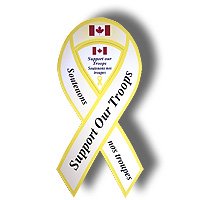The parents of deceased Canadian soldier Marc Diab, mother Jihani Diab and father Hani, take a moment at home with a picture of their late son, Marc. The Canadian trooper was killed three years ago in Afghanistan by an IED.
Colin McConnell/Toronto Star Mary OrmsbyFeature WriterWritten for The Toronto Star
Young Marc Diab and his family would halt, standing still on the roadside, whenever Israeli tanks lurched through the streets of their Lebanese village in the 1990s.
But in those tanks, filled with gun-toting troops, little Marc saw his: life as a soldier.
“He used to say, even back in Lebanon when we used to have the Israeli army go through our streets all the time, ‘I want to be a soldier, I want to be a soldier,’” recalls eldest sister Jessica Diab, 30, of the time her brother was about 8.
But Diab would not fight for Lebanon, where an only son is not permitted to enlist. He became a soldier in Canada, the peaceful country that lured his family from Ain-Ebel to Mississauga 12 years ago. But the soldier — who would die in Afghanistan at age 22 — carried a secret. A premonition of his death. One so strong that he made a farewell video for his family and entrusted a friend to show it at his funeral.
To see video footage the day of the funeral, click here
Diab’s extraordinary story is the focus of an award-winning documentary If I Should Fall, which was invited to the GI Film Festival in Washington, D.C. Directed by 24-year-old Brendon Culliton of London, Ont., it will premiere Thursday at the Canadian Embassy before nearly 200 guests, including Pentagon officials.
On March 8, 2009, Trooper Marc Diab of the Royal Canadian Dragoons, Squadron D, based in Petawawa, became the 112th of 158 Canadians to die during Canada’s combat mission in Afghanistan. (See blog entry)
When Diab died, his LAV III crippled by an improvised explosive device, he left behind front-line video diaries.
A camera junkie, Diab’s calm narrative beneath images of the inane and the tragic — including the battlefield helicopter removal of his friend, Trooper Brian Good, killed Jan. 7, 2009, in an IED attack — is part of the emotional wallop Culliton delivers in the documentary. Two more Squadron D troopers, Corey Hayes and Jack Bouthillier, were killed two weeks after Diab.
Brandon L. Millett., co-founder of the GI Film Festival, says Culliton’s film was chosen because it’s a “beautifully crafted story about one Canadian family.”
“It is such a moving demonstration of how sacrifice and suffering are a universal experience for military families around the world,” Millett says of the feature-length film.
“Those who attend this film screening will never forget Trooper Marc Diab and the sacrifice he made for his country and for the cause of freedom.”
But there was more to Trooper Diab than soldiering.
He organized children’s summer camps through his Maronite Catholic Church, Our Lady of Lebanon. He coached youth soccer in Petawawa. Learned to play music by ear, filling family gatherings with Arabic melodies or modern rock on a Yamaha keyboard.
Diab wrote poetry. He harangued his restaurateur brother-in-law to open a shawarma joint in Petawawa because ethnic food choice was limited. He produced videos and had more than 3,000 photographs stored at home. He threw chocolates and candies to Afghan kids, even when they threw back stones.
Diab was also a loving boyfriend.
In the documentary, there’s a home video of Diab and girlfriend Mary Barakat in a car, carefree, the wind ruffling their hair on a sunny day.
They lean toward each other and share a soft, yielding kiss. She is joyful, radiant, because he has made her so.
A CANADIAN soldier’s life was cheap in Afghanistan.
A few dollars’ worth of materials — fertilizer, diesel fuel, a detonator — and the highly effective IED was ready to kill. Such homemade bombs caused most of the 158 Canadian casualties, most of the horrific maimings, most of a wide range of physical injuries that included mild to severe brain traumas from the shock-wave effect.
But roadside bombs were Plan B, says retired Maj.-Gen. Lewis MacKenzie.
MacKenzie says Taliban fighters were no match for Canadian combat troops in face-to-face engagements around Kandahar in 2005 and early 2006, when insurgents were “soundly trounced.”
“Not being stupid,” MacKenzie says, the Taliban rethought their strategy.
“They stepped back one rung on the ladder of escalation and that step back in any number of insurgencies becomes the booby trap,” MacKenzie explains.
It’s a method that allows detonation from afar — a cellphone, for instance, can trigger an IED. Some are pressure sensitive. A booted foot, a tank, will do.
Canadian troopers like Diab would have known those risks, says Maj. Ray Wiss, a veteran emergency physician who served in Afghanistan in 2007 and is the author of two books recounting his combat experiences.
“We do train for almost a year to go on one of these tours — and it’s made pretty clear to them they’re not all coming home,” says Wiss, who was previously a Canadian Forces combat soldier.
The Sudbury doctor does quick calculations. Of the 3,000 Canadians deployed to Afghanistan at any given time, about 1,000 were combat troops. The rest were support personnel.
Wiss figures there was about a 2 per cent chance of a Canadian being killed and another 2 per cent chance of being “very badly mangled.”
“You knew that going in,” Wiss says.
Diab was comfortable with those odds, says his father, Hani.
“I would tell Marc, ‘I’m a brave man in words, I am a strong man, but you did it. To wear the uniform and to take a gun and go make a change somewhere in the world, this is something noble. I couldn’t do what you’re doing,’” Hani Diab recalls telling his son.
“He had guts.”
Sitting calmly in a convoy’s lead vehicle took guts.
“All things being equal, the first vehicle is the most vulnerable,” says Wiss.
Diab was in the lead vehicle the day of his death. In the documentary, his fellow troops recall their fun-loving buddy was not himself. Tired. Quiet.
Did Diab sense his death was imminent? Or was he merely fatigued, his six-month tour due to end in three weeks?
The bomb rocked Diab’s armoured vehicle around 1:15 p.m. local time, north of Kandahar City. Four others were injured, three of them badly. Diab was dead, his omnipresent camera beneath his body, destroyed.
Diab’s body was saluted by throngs of Canadians lining bridges, many from the Lebanese-Canadian community, along the Highway of Heroes en route to the coroner’s office in downtown Toronto. About 1,000 people attended his funeral mass, during which Diab’s farewell video was shown.
His parents had no idea it existed.
Their son had edited silent images of family and friends, played to music. It closed with words he’d written for them:
“Don’t cry . . . ’cause I’ll see you tomorrow.”
SUNDAY WILL BE Jihan Diab’s fourth Mother’s Day without her son, Marc.
She turned 50 on Wednesday. Festive birthday balloons taped to the walls by daughters Jessica and Maya are still up a day later, save for one. Four-year-old grandson Anthony is madly hoofing the balloon around the spacious, sun-filled home, kicking it like a soccer ball.
Anthony looks very much like his uncle. Large brown eyes, thick dark lashes, a shock of curly black hair.
Jihan is elegant, poised, in this lasting grief. She speaks strongly. Even though tears begin to flow, she does not falter.
“I am a happy mother, reaching this age, raising up a good family. I know Marc is not with us physically but he doesn’t leave us,” she says.
“I don’t deal with my loss as a loss. It’s too complicated to explain. I miss his presence, I miss his smell, I miss his touch and hug and this mother-son feeling. But, at the same time, I know that the minute I lost Marc physically, I tried to ask why. Everybody asks. ‘Why me? Why? Why?’”
She pauses for a moment. Hani, her husband, is silent, respectful.
“I closed my eyes, I saw Jesus. I saw a light. I could never explain how. And I saw Marc’s face beside Jesus. So that is when I said: ‘That’s it. I am not supposed to mourn Marc, I am going to live Marc. This is how I will honour him. I will live Marc.’”
As a family, the Diabs are active in keeping their son’s memory alive.
That shawarma joint Marc wanted? It’s now reality. The extended Diab family opened Madameek (a Lebanese word for “many bricks,” Jihan Diab says, meaning strength and protection) in 2010.
It’s a place that honours not only their son but all Canadians who died in Afghanistan.
“We see families from all over Canada,” Hani says, proudly.
“From Kingston, they come to eat in Petawawa, to see Marc’s story, to live it, to see all the pictures in the restaurant. We have all fallen soldiers’ pictures in the restaurant because (it’s) not only dedicated to Trooper Marc Diab, it’s dedicated to Trooper Marc Diab and all the fallen heroes in Afghanistan.”
Two months ago, the Diabs opened a second Madameek in Pembroke.
Closer to home, a stone monument tucked into the Diabs’ front lawn gracefully calls attention to their son. His image and the words “Our hero, son, trooper” are inscribed on a plaque. Jihan’s licence plate is: MARCDIAB.
There is a website, marcdiab.com full of photos and information; a children’s foundation in his name; a Mississauga memorial park christened for him, just a few minutes from the Diab home. Last year at the Hershey Centre, his family was honoured at a hockey game, Hani dropping the ceremonial faceoff puck.
Culliton hopes If I Should Fall finds a wider audience to educate the Canadian public about what military families endure during combat missions and, in this case, after a death.
“Even though this film is like an emotional roller-coaster, at no point do I want people to be uncomfortably sad,” says Culliton, who is donating DVD proceeds to the Marc Diab Children’s Foundation and the Military Families Fund.
“I want people to walk away and let it stay with you.”
DVD "If I Should Fall" is available for purchase
 Or Use
Or Use

Proceeds from DVD sales go towards
The Marc Diab Children's Foundation and The Military Families Fund



























No comments:
Post a Comment